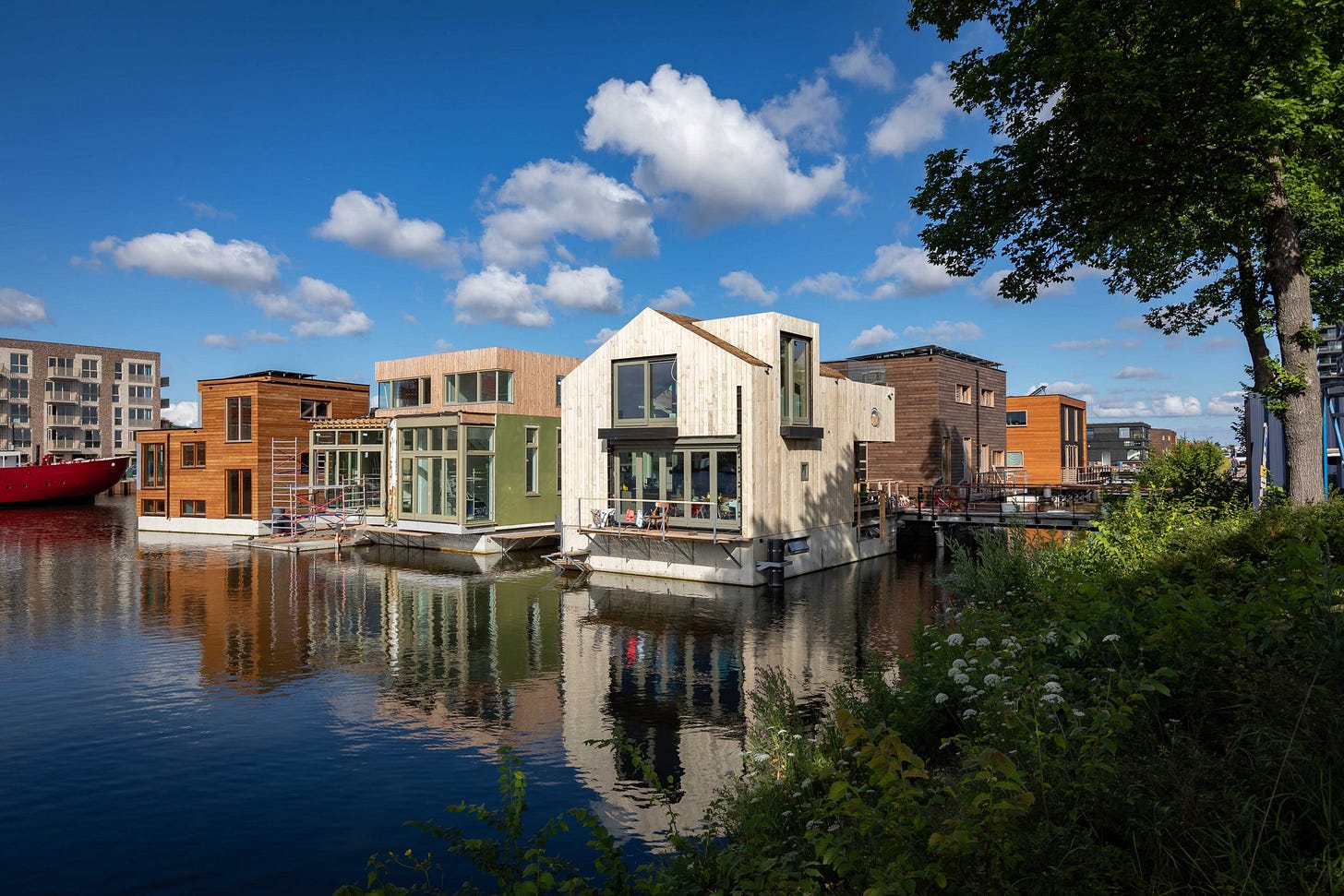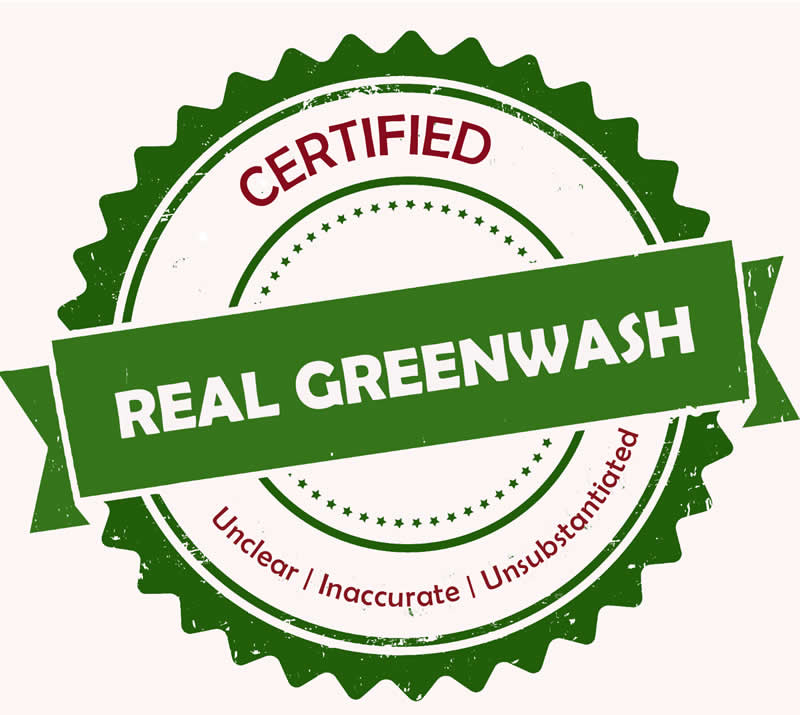16 December 2021. Cities | Greenwashing
The floating cities of our future. | Maybe it’s time that greenwashing got a certification process all of its own.
Welcome to Just Two Things, which I try to publish daily, five days a week. Some links may also appear on my blog from time to time. Links to the main articles are in cross-heads as well as the story.
#1: The floating cities of the future
As ocean levels rise, we’re becoming more interested in what it means to build cities that sit on the water rather than get inundated by it. The Dutch, inevitably, know more than this than most people, having spent hundreds of years managing a complex relationship between land and sea. The neighbourhood of Schoonschip, in Amsterdam, therefore, might be thought of as something of a prototype. There’s an article on Yale 360 that explores the idea of floating cities—and what we can learn from the Dutch.
(Schoonschip: photo by Isabel Nabuurs. https://schoonschipamsterdam.org/en/)
Schoonschip itself is still quite small: 30 houses on one of Amsterdam’s canals. It’s also an experiment in living, since community members share resources; the buildings have green rooves and solar panels.
It’s not the only place. Rotterdam, largely built below sea level, has also been developing floating buildings:
Rotterdam, which is 90 percent below sea level and the site of Europe’s biggest port, is home to the world’s largest floating office building, as well as a floating farm where cows are milked by robots, supplying dairy products to local grocery stores. Since the 2010 launch of the Floating Pavilion, a solar-powered meeting and event space in Rotterdam’s harbor, the city has been ramping up efforts to mainstream such projects, naming floating buildings one of the pillars of its Climate Proof and Adaptation Strategy.
Arnoud Molenaar, the Chief Resilience Officer of Rotterdam (the title tells you something), told the article’s author that “Instead of seeing water just as an enemy, we see it as an opportunity.”
One of the things that has opened up this opportunity has been a different way of seeing urban space that goes back 15 years. Some areas were designated as “Room for the River” locations which would be expected to flood for part of the year, and therefore could be used for floating buildings. (Obviously this makes more sense than the British approach, which was to allow conventional housing to be built on areas that were likely to flood.) There are likely to be further changes to zoning laws as the Netherlands wrestles with its housing shortage.
A floating house can be constructed on any shoreline and is able to cope with rising seas or rain-induced floods by floating atop the water’s surface. Unlike houseboats, which can easily be unmoored and relocated, floating homes are fixed to the shore, often resting on steel poles, and are usually connected to the local sewer system and power grid. They are structurally similar to houses built on land, but instead of a basement, they have a concrete hull that acts as a counterweight, allowing them to remain stable in the water.
The Dutch versions can be three storeys high, and are often largely pre-fabricated. The technology involved is not especially complex. One result of the early start that the Dutch have in the technology is that Dutch firms are now working on projects elsewhere in the world—closer to home in Britain, France, Norway, and the Baltic Sea, and further afield in French Polynesia and the Maldives, a country that could be obliterated by rising sea levels:
(The Dutch company) Waterstudio will oversee construction this winter of a floating housing development near the low-lying capital of Male in the Maldives, where 80 percent of the country sits less than one meter above sea level. It is composed of simply designed, affordable housing for 20,000 people. Underneath the hulls will be artificial coral to help support marine life. The buildings will pump cold seawater from the deep to power air conditioning systems.
There are technical issues here, of course. The infrastructure connections, for water and sewage and power, need to be particularly robust. It can take time for residents to get used to the notion that the house starts to rock when the wind blows or a boat passes, although it seems that people get used to it. But in the face of both rising sea levels and increasingly sever floods, the difficulties seem modest:
Rutger de Graaf, the cofounder and director of Blue21, said that the growing number of disastrous, unprecedented storms around the world has spurred both city planners and residents to look to the water for solutions... “If there are floods, it’s expected that many people will move to higher ground. But the alternative is to stay close to coastal cities and explore expansion onto the water,” says De Graaf. “If you consider that in the second half of the century, hundreds of millions of people will be displaced by sea level rise, we need to start now to increase the scale of floating developments.”
Reading the piece, I was reminded that quite a lot of the futures literature of the ‘60s was, to put it mildly, a bit obsessed by the idea of underwater cities. This might have been an offshoot of the then ever-present idea of space colonies. (Just like in space! But on earth!) The problems of feeding these cities, let alone ensuring that people could breathe, tended to be skated across. Sometimes credible futures ideas don’t need to be that complicated.
(Schematic of Schoonschip: [https://schoonschipamsterdam.org/en/])
#2: Maybe it’s time that greenwashing got a certification process all of its own
I enjoyed a post on the blog of the sustainability consultancy Terrafiniti which identified a new gap in the sustainability market: the lack of a decent ‘greenwashing kitemark’.
(For anyone reading this quickly: Dominic Tantram’s post is definitely satirical. Please don’t go to the site to complain or shame them on Twitter).
(Source: Terrafiniti)
It’s also not that long, so I’ll just pull out a couple of highlights.
You might consider yourself an old hand at greenwashing.
Perhaps you’ve made some truly outrageous claims with virtually no basis in fact.
You think you’re top at the top of your game.
But you have a little voice in your ear – ‘what if someone else is making claims even more mendacious than ours?’
It’s time to get professional. So, we’re pleased to announce the new Real Greenwash KitemarkTM.
As Dominic says, a decent ‘Real GreenwashTM’ is just what you need to lead your customers and stakeholders “down the garden path”. All the same, really nebulous and unsubstantiated claims require real work, and this is where Terrafiniti hopes that its new (and entirely imaginary) product and process will come in handy:
Here are some simplified criteria to apply to see if your copy and collateral are suitably deficient and can meet the level of a top dissembler.
Real GreenwashTM statements must ensure that they comply with at least 2 of the following 3 tests:
Claims must be demonstrably unclear
They must be wildly (or at least substantially) inaccurate
Claims should be totally, or at the least significantly, unsubstantiated.1
j2t#229
If you are enjoying Just Two Things, please do send it on to a friend or colleague.
Demonstrating truly unsubstantiated claims can be difficult. To support your ability to comply, the Real GreenwashTM standard gives you the flexibility you need. Even if some portion of your rhetoric turns out to be partially true you can still achieve certification on other counts. (Their footnote)





